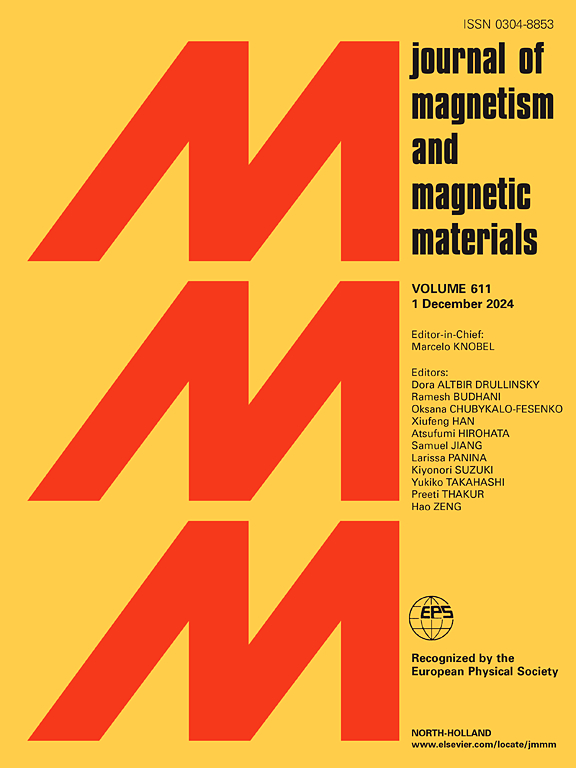磁场辅助3D打印各向异性磁流变弹性体:TPU-CIP复合材料的性能增强和链取向机制
IF 2.5
3区 材料科学
Q3 MATERIALS SCIENCE, MULTIDISCIPLINARY
引用次数: 0
摘要
本研究探讨了磁场辅助3D打印在增材制造中提高磁流变弹性体(MREs)综合性能的潜力。传统的磁流变仪在结构复杂性方面存在局限性,而3d打印的磁流变仪(p-MREs)由于材料的限制,在绝对和相对磁流变(MR)效应之间表现出较差的平衡。为了解决这个问题,我们开发了一种将热塑性聚氨酯(TPU)与羰基铁粉(CIP)结合在一起的方法,并在熔融沉积建模(FDM)过程中集成了辅助磁场。定制设计的SmCo永磁器件产生稳定的500 mT磁场,诱导各向异性并抑制环状CIP结构。通过扫描电镜(SEM)和流变学测试的微观结构分析表明,磁场辅助印刷改善了材料的各向异性和磁流变效应,在1 t条件下,材料的相对磁流变效应为440.6%,绝对磁流变效应为2.0 MPa,与各向同性p-MREs(相对磁流变率为387.2%,绝对磁流变率为1.7 MPa)相比,材料的综合性能提高了13.8%,但仍落后于传统的各向异性磁流变学。该研究还发现了链状CIP排列与磁滞减少之间的相关性,这表明软磁磁磁共振成像可以模拟磁场辅助下的硬磁行为。与之前使用硬磁填料的工作不同,我们的TPU-CIP p-MREs通过场辅助校准实现了类似硬磁的行为(例如扭曲),具有成本和环境优势。这些发现推动了智能材料的设计,用于需要平衡刚度和可调性的应用,如汽车阻尼器和软机器人。本文章由计算机程序翻译,如有差异,请以英文原文为准。
Magnetic field-assisted 3D printing of anisotropic magnetorheological elastomers: Performance enhancement and chain alignment mechanism in TPU-CIP composites
This study investigates the potential of magnetic field-assisted 3D printing to enhance the comprehensive performance of magnetorheological elastomers (MREs) in additive manufacturing. Traditional MREs face limitations in structural complexity, while 3D-printed MREs (p-MREs) exhibit inferior balance between absolute and relative magnetorheological (MR) effects due to material constraints. To address this, we developed a method combining thermoplastic polyurethane (TPU) with carbonyl iron powder (CIP) and integrated an auxiliary magnetic field during fused deposition modeling (FDM). A custom-designed SmCo permanent magnet device generated a stable 500 mT field to induce anisotropy and suppress ring-shaped CIP structures. Microstructural analysis via scanning electron microscopy (SEM) and rheological testing revealed that magnetic field-assisted printing improved anisotropy and MR effects, achieving a relative MR effect of 440.6 % and absolute MR effect of 2.0 MPa under 1 T. Compared to isotropic p-MREs (relative MR: 387.2 %, absolute MR: 1.7 MPa), the comprehensive performance was enhanced by 13.8 %, though still lagging behind traditional anisotropic MREs. The study also identified a correlation between chain-like CIP alignment and reduced magnetic hysteresis, suggesting that soft magnetic MREs can mimic hard magnetic behaviors under field assistance. Unlike prior works using hard magnetic fillers, our TPU-CIP p-MREs achieved hard magnetic-like behavior (e.g., twisting) via field-assisted alignment, offering cost and environmental advantages. These findings advance the design of smart materials for applications requiring balanced stiffness and tunability, such as automotive dampers and soft robotics.
求助全文
通过发布文献求助,成功后即可免费获取论文全文。
去求助
来源期刊

Journal of Magnetism and Magnetic Materials
物理-材料科学:综合
CiteScore
5.30
自引率
11.10%
发文量
1149
审稿时长
59 days
期刊介绍:
The Journal of Magnetism and Magnetic Materials provides an important forum for the disclosure and discussion of original contributions covering the whole spectrum of topics, from basic magnetism to the technology and applications of magnetic materials. The journal encourages greater interaction between the basic and applied sub-disciplines of magnetism with comprehensive review articles, in addition to full-length contributions. In addition, other categories of contributions are welcome, including Critical Focused issues, Current Perspectives and Outreach to the General Public.
Main Categories:
Full-length articles:
Technically original research documents that report results of value to the communities that comprise the journal audience. The link between chemical, structural and microstructural properties on the one hand and magnetic properties on the other hand are encouraged.
In addition to general topics covering all areas of magnetism and magnetic materials, the full-length articles also include three sub-sections, focusing on Nanomagnetism, Spintronics and Applications.
The sub-section on Nanomagnetism contains articles on magnetic nanoparticles, nanowires, thin films, 2D materials and other nanoscale magnetic materials and their applications.
The sub-section on Spintronics contains articles on magnetoresistance, magnetoimpedance, magneto-optical phenomena, Micro-Electro-Mechanical Systems (MEMS), and other topics related to spin current control and magneto-transport phenomena. The sub-section on Applications display papers that focus on applications of magnetic materials. The applications need to show a connection to magnetism.
Review articles:
Review articles organize, clarify, and summarize existing major works in the areas covered by the Journal and provide comprehensive citations to the full spectrum of relevant literature.
 求助内容:
求助内容: 应助结果提醒方式:
应助结果提醒方式:


